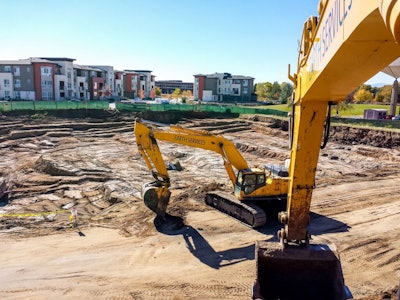
Information from this article was first published in Demolition Magazine and is being reused with permission from the National Demolition Association.
By Paula Black
The huge Stapleton Redevelopment Project near Denver is still underway of its transformation from an international airport to a thriving residential and mixed-use community. While many local organizations and businesses have come together over the ongoing 16-year project, Earth Services & Abatement (ESA) of Commerce City, CO, has maintained its working presence in Stapleton, completing multiple phases since the project’s early years. Final phases of asbestos abatement and soil remediation are in progress, with a finish date slated for September.
The 4,700-acre site was home to the Stapleton International Airport in 1919 and then Denver International Airport in 1929. However, as the city began to grow, Denver officials decided to close down the airport in Stapleton and move it to its present-day location, about 15 miles east of the former site.
In 1990, the Stapleton Foundation was created; then, in 1995, after the Stapleton airport officially closed, the foundation published the Stapleton Redevelopment Plan, commonly referred to as the “Green Book.” The plan called for the establishment of jobs and open rec spaces in a new mixed-use neighborhood. Approved by the Denver City Council in 1995, the Green Book was the foundation for the work that is still taking place in the Stapleton community.
Greg Holt, director of transportation systems at Denver International Airport and program manager for the Stapleton Redevelopment Project, has worked on the project since its inception. Holt has worked with the City and County of Denver for over 35 years and served as chief airport operations manager at the Stapleton International Airport before its closure in 1995.
Holt has been involved with multiple stakeholders and agencies to make sure the redevelopment meets all of the goals and regulations set in place. He also worked closely with ESA to see that all the demolition, remediation and asbestos abatement work was on schedule.
“The Stapleton Redevelopment Project is fortunate to have engaged numerous consultants, general contractors for both demolition and environmental remediation, and federal, state and city agencies to achieve our goal,” Holt says.
ESA is currently completing the last major landfill remediation on the Highline Canal, Phase II portion of the project. This area is approximately 45,000 cubic yards of landfill material from a 1960s-era landfill site. ESA is working concurrently on the former control tower abatement to make way for a new highlight of the redevelopment project, Punch Bowl Social — a popular bar, restaurant and bowling alley.
ESA has been responsible for much of the abatement and remediation throughout the life of the project and is one of the few abatement firms in the U.S. capable of performing all of its work in-house. The company has performed the abatement and demolition of the Sand Creek Bridges, multiple hangars and the abatement of the control tower; in addition, the company is responsible for over 1 million yards of landfill and soil remediation.
Opportunity
When ESA first went under contract at Stapleton in the 1990s, no one knew how much contamination would be encountered, according to Kory Mitchell, president of ESA. Then, because of the landfill cleanups and soil remediation work, the contract work ended up topping out at more than $30 million. The work was not only fiscally rewarding, but gave the company a new avenue of work as well.
“At the beginning of our work with the Stapleton Redevelopment Project, we started an interior asbestos abatement company. Through the process of working on this project, we have become a full turnkey environmental cleanup and soil remediation contractor,” Mitchell says. “So, in a lot of ways, our growth and transformation was driven by our work in Stapleton.”
Although the work is not yet fully completed, the transformation of the former airport site is already home to 20,000-plus residents living in that area. “This was a significant project and really helped to transform the community of Stapleton,” Mitchell says. “ESA’s operational model mirrored that transformation.”
ESA emerged from its reputation as a leading abatement company to a prominent soil remediation firm. The firm has technically not left the Stapleton site (between multiple phases of the project) from 2006 to the present, and in those 10 years on the ground, the project has helped shape the company, especially in Colorado. ESA operates as an asbestos abatement firm in 33 states, but Colorado is the only state where the firm currently performs large-scale soil remediation work.
“Now — because of the work done at Stapleton — ESA does more contaminated soil work than any other firm in Colorado,” Mitchell says. “We still do plenty of interior abatement in the state, but I would say contaminated soil work is now between 40% to 50% of our revenue, and of course Stapleton was a major part of this shift.”
During its time on-site, ESA evolved from primarily an asbestos abatement company — using labor — to a company that earns more than half of its revenue from heavy equipment work, which is “unusual” for the abatement industry, according to Mitchell.
Setting the standard
To date, the Stapleton project has included the demolition of over 120 buildings, remediation of 50 site projects and recycling of more than 200 million tons of concrete and asphalt. ESA has performed a significant portion of this work with a particular focus on abatement and soil remediation.
“Initially, [the project] began with an environmental standard that would be used on the site throughout the program duration. The standard, called the Stapleton Numeric Criteria (SNC), was approved by the Environmental Protection Agency (EPA), State of Colorado, the city and, later, the insurance company,” Holt says.
Holt says that setting the SNC standard was important in the remediation efforts because it set the bar for the projects. “We have remediated numerous old landfills including sections of an old High Line Canal lateral that crisscrossed the Stapleton site,” he says. “The program remediated the airport-type of contaminated soil, which was due to jet fuel and deicing fluid. We have disposed of over a million yards of contaminated soil from these projects.”
Holt explained that the project is still ongoing, requiring two to three years before all of the land is transferred and six to 10 years before the site is fully developed.
“It has been a great project overall,” Holt says. “After all, how many projects give you the opportunity to demolish over 120 buildings, not to mention the demolition of major bridge structures for runways and taxiways, over creeks and over a main line railroad?”
“We were fortunate to be one of the first cleanup contractors on the Stapleton site in the late 1990s,” Mitchell says, “and now we are likely to be the last to leave. Over nearly 20 years, the project has shaped our small, family-owned firm into one of the most significant environmental firms in the Rocky Mountains.”

















